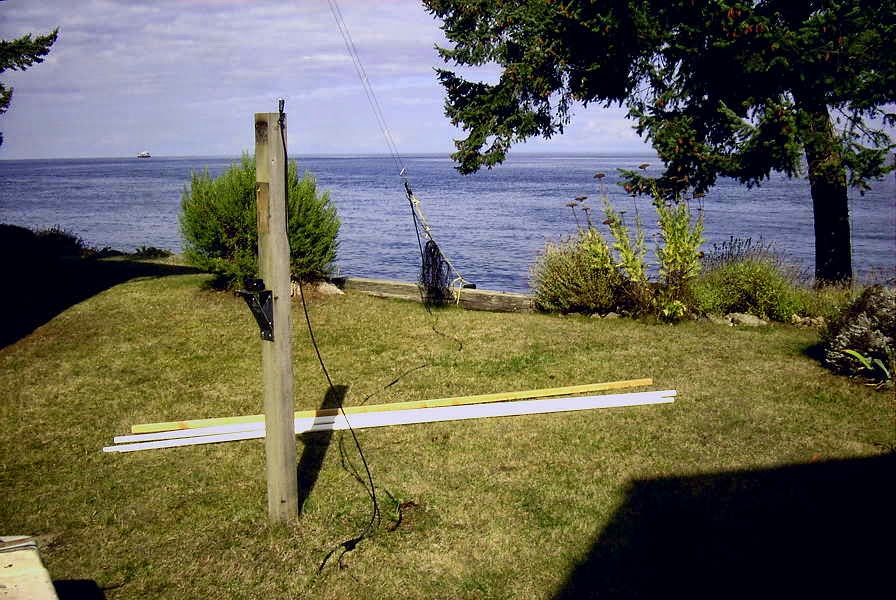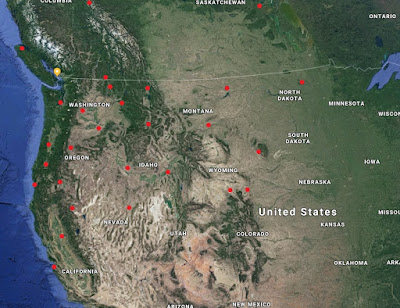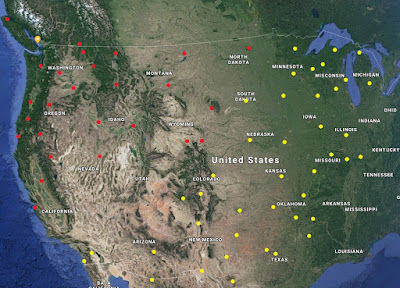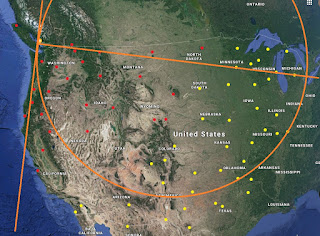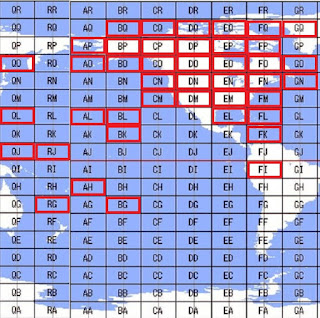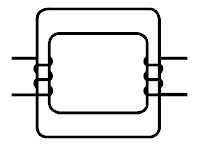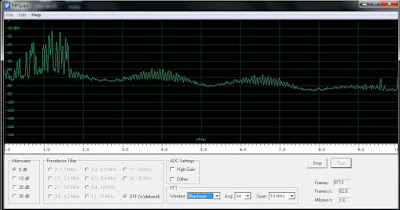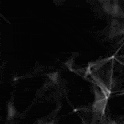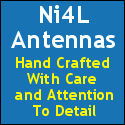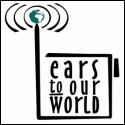Posts Tagged ‘Perseus’
 Recent BCB Loop DX / Upcoming CLE248
Recent BCB Loop DX / Upcoming CLE248
This past week has seen a welcome return to better band conditions on the lower frequencies.
I’ve had my 10' x 20' loop and Perseus SDR combination running a few overnight recordings on the AM broadcast band ... two mornings pointing at Asia and two overnights looking for domestic signals from the east.
The Asian signals have often been very strong, with many signals reaching S9 or higher. I’ve chosen some of the better ones below. Unlike those situated right on the west coast, my location here on Mayne Island gives me a nice shot towards Japan albeit not directly over the ocean, but close enough, as the path crosses islands to my north and then over northern Vancouver Island.
Looking towards eastern North America is a different story, with an unobstructed ocean view from due north to the south east.
As is often the case with overnight recordings, I did not get nearly enough time to thoroughly check them out but one catch caught my attention. It was from WPTX in Lexington Park, Maryland, on 1690kHz. This station supposedly runs 1kW at night and 10kW during the day but on this night (Sept 16), I heard their top-of-hour ID for three consecutive hours! I wonder if someone ‘forgot’ to switch to nightime power or if conditions were just really good? I have heard them again since with two TOH IDs but much weaker and sounding more like a 1kW station should sound!
JOAK - 594kHz in Shobu, Japan (13:30 UTC Sept 20)
JOUB - 774kHz in Akita, Japan (14:00 UTC Sept 20)
(with English lessons)
HLAZ - 1566kHz in Cheju, South Korea (13:30 UTC Sept 20)
(broadcasting in Japanese in this time slot)
Voice of America (VOA) - 1575kHz in Ban Phachi, Thailand (13:30 UTC Sept 20)
(listen for "This is the Voice of America" ID and then into "Yankee-Doodle-Dandy")
************************
Yes! Another month has passed and it's CLE time once again.
This time the hunting grounds will be: 275 kHz - 425 kHz.
For those unfamiliar with this monthly activity, a 'CLE' is a 'Co-ordinated Listening Event', as NDB DXers around the world focus their listening time on one small slice of the NDB spectrum.
If you've been meaning to participate in CLE, then maybe this weekend is a fine time to try! Lately, we've had a lot of first time submissions so you won't be alone!
As well, if you're trying to learn CW, copying NDBs is perfect practice, as the identifier speed is generally slow and the letters are repeated again every few seconds!
At this time of the season, summer lightning storms should be starting to wane and propagation can often be as good as mid-winter if the lightning cooperates.
When tuning for NDBs, put your receiver in the CW mode and listen for the NDB's CW identifier, repeated every few seconds. Listen for U.S. NDB identifiers approximately 1 kHz higher or lower than the published transmitted frequency since these beacons are modulated with a 1020 Hz tone approximately.
For example, 'AA' near Fargo, ND, transmits on 365 kHz and its upper sideband CW identifier is tuned at 366.025 kHz while its lower sideband CW ident can be tuned at 363.946 kHz. Its USB tone is actually 1025 Hz while its LSB tone is 1054 Hz.
Often, one sideband will be much stronger than the other so if you don't hear the first one, try listening on the other sideband.
Canadian NDBs normally have an USB tone only, usually very close to 400 Hz. They also have a long dash (keydown) following the CW identifier.
All NDBs heard in North America will be listed in the RNA database (updated daily) while those heard in Europe may be found in the REU database. Beacons heard outside of these regions will be found in the RWW database.
From CLE organizer Brian Keyte, G3SIA, comes the details:
Hi all
Our 248th Listening Event just squeezes into the last weekend of this month.
Worth waiting for because it is a 'Special', our fifth 'Channels Challenge'.
It's a simple idea, but one that we always seem to enjoy:
Days: Friday 27 September - Monday 30 September
Times: Start and end at midday, your LOCAL time
Range: 275 kHz - 425 kHz (see below)
Target: Try to log ANY ONE NDB in each channel
The 'channel' means the NDB's nominal (published) frequency.
EITHER 321.0 OR 321.5 kHz would be OK for channel 321, etc.
So it means a possible maximum of 151 loggings in all, though that would
probably be miraculous, even for the best placed of us!
All the NDBs must be 'normal' ones (no DGPS, Amateur, etc.) and
no UNIDs in your main list. Yes, it does include those more
challenging frequencies in the DGPS range.
If you want to add extra interest you could also choose to:
Maximise the number of radio countries you hear or
Maximise the total distance to the NDBs you hear or
Maximise the number of 'midday' loggings - i.e. NDBs logged
within 2 hours of midday by your local winter clock time.
It will be extra tough for North American listeners, with their many 'empty'
channels. Southern Hemisphere and Europe listeners should be more lucky.
Our last 'Channels Challenge' was CLE231 in April 2018.
Please look out for the 'Final Details' a few days before the start.
73
Brian
-------------------------------------------------------------------------
From: Brian Keyte G3SIA (CLE coordinator)
ndbcle'at'gmail.com
-------------------------------------------------------------------------
These listening events serve several purposes. They:
The NDB List Group is a great place to learn more about the 'Art of NDB DXing' or to meet other listeners in your region. There is a lot of good information available there and new members are always very welcome. As well, you can follow the results of other CLE participants from night to night as propagation is always an active topic of discussion.
You need not be an NDB List member to participate in the CLEs and all reports, no matter how small, are of much value to the organizers.
Remember - 'First-time' logs are always VERY welcome!
Reports may be sent to the NDB List Group or e-mailed to CLE co-ordinator, Brian Keyte (G3SIA), whose address appears above. If you are a member of the group, all final results will also be e-mailed and posted there.
Please ... give the CLE a try ... then let us know what NDB's can be heard from your location! Your report can then be added to the worldwide database to help keep it up-to-date.
Have fun and good hunting!
I’ve had my 10' x 20' loop and Perseus SDR combination running a few overnight recordings on the AM broadcast band ... two mornings pointing at Asia and two overnights looking for domestic signals from the east.
The Asian signals have often been very strong, with many signals reaching S9 or higher. I’ve chosen some of the better ones below. Unlike those situated right on the west coast, my location here on Mayne Island gives me a nice shot towards Japan albeit not directly over the ocean, but close enough, as the path crosses islands to my north and then over northern Vancouver Island.
Looking towards eastern North America is a different story, with an unobstructed ocean view from due north to the south east.
As is often the case with overnight recordings, I did not get nearly enough time to thoroughly check them out but one catch caught my attention. It was from WPTX in Lexington Park, Maryland, on 1690kHz. This station supposedly runs 1kW at night and 10kW during the day but on this night (Sept 16), I heard their top-of-hour ID for three consecutive hours! I wonder if someone ‘forgot’ to switch to nightime power or if conditions were just really good? I have heard them again since with two TOH IDs but much weaker and sounding more like a 1kW station should sound!
JOAK - 594kHz in Shobu, Japan (13:30 UTC Sept 20)
JOUB - 774kHz in Akita, Japan (14:00 UTC Sept 20)
(with English lessons)
HLAZ - 1566kHz in Cheju, South Korea (13:30 UTC Sept 20)
(broadcasting in Japanese in this time slot)
Voice of America (VOA) - 1575kHz in Ban Phachi, Thailand (13:30 UTC Sept 20)
(listen for "This is the Voice of America" ID and then into "Yankee-Doodle-Dandy")
************************
Hunting For NDBs In CLE248
Yes! Another month has passed and it's CLE time once again.
This time the hunting grounds will be: 275 kHz - 425 kHz.
For those unfamiliar with this monthly activity, a 'CLE' is a 'Co-ordinated Listening Event', as NDB DXers around the world focus their listening time on one small slice of the NDB spectrum.
If you've been meaning to participate in CLE, then maybe this weekend is a fine time to try! Lately, we've had a lot of first time submissions so you won't be alone!
As well, if you're trying to learn CW, copying NDBs is perfect practice, as the identifier speed is generally slow and the letters are repeated again every few seconds!
At this time of the season, summer lightning storms should be starting to wane and propagation can often be as good as mid-winter if the lightning cooperates.
When tuning for NDBs, put your receiver in the CW mode and listen for the NDB's CW identifier, repeated every few seconds. Listen for U.S. NDB identifiers approximately 1 kHz higher or lower than the published transmitted frequency since these beacons are modulated with a 1020 Hz tone approximately.
For example, 'AA' near Fargo, ND, transmits on 365 kHz and its upper sideband CW identifier is tuned at 366.025 kHz while its lower sideband CW ident can be tuned at 363.946 kHz. Its USB tone is actually 1025 Hz while its LSB tone is 1054 Hz.
Often, one sideband will be much stronger than the other so if you don't hear the first one, try listening on the other sideband.
Canadian NDBs normally have an USB tone only, usually very close to 400 Hz. They also have a long dash (keydown) following the CW identifier.
All NDBs heard in North America will be listed in the RNA database (updated daily) while those heard in Europe may be found in the REU database. Beacons heard outside of these regions will be found in the RWW database.
From CLE organizer Brian Keyte, G3SIA, comes the details:
Hi all
Our 248th Listening Event just squeezes into the last weekend of this month.
Worth waiting for because it is a 'Special', our fifth 'Channels Challenge'.
It's a simple idea, but one that we always seem to enjoy:
Days: Friday 27 September - Monday 30 September
Times: Start and end at midday, your LOCAL time
Range: 275 kHz - 425 kHz (see below)
Target: Try to log ANY ONE NDB in each channel
The 'channel' means the NDB's nominal (published) frequency.
EITHER 321.0 OR 321.5 kHz would be OK for channel 321, etc.
So it means a possible maximum of 151 loggings in all, though that would
probably be miraculous, even for the best placed of us!
All the NDBs must be 'normal' ones (no DGPS, Amateur, etc.) and
no UNIDs in your main list. Yes, it does include those more
challenging frequencies in the DGPS range.
If you want to add extra interest you could also choose to:
Maximise the number of radio countries you hear or
Maximise the total distance to the NDBs you hear or
Maximise the number of 'midday' loggings - i.e. NDBs logged
within 2 hours of midday by your local winter clock time.
It will be extra tough for North American listeners, with their many 'empty'
channels. Southern Hemisphere and Europe listeners should be more lucky.
Our last 'Channels Challenge' was CLE231 in April 2018.
Please look out for the 'Final Details' a few days before the start.
73
Brian
-------------------------------------------------------------------------
From: Brian Keyte G3SIA (CLE coordinator)
ndbcle'at'gmail.com
-------------------------------------------------------------------------
These listening events serve several purposes. They:
- determine, worldwide, which beacons are actually in service and on-the-air so the online database can be kept up-to-date
- determine, worldwide, which beacons are out-of-service or have gone silent since the last CLE covering this range
- will indicate the state of propagation conditions at the various participant locations
- will give you an indication of how well your LF/MF receiving system is working
- give participants a fun yet challenging activity to keep their listening skills honed
The NDB List Group is a great place to learn more about the 'Art of NDB DXing' or to meet other listeners in your region. There is a lot of good information available there and new members are always very welcome. As well, you can follow the results of other CLE participants from night to night as propagation is always an active topic of discussion.
You need not be an NDB List member to participate in the CLEs and all reports, no matter how small, are of much value to the organizers.
Remember - 'First-time' logs are always VERY welcome!
Reports may be sent to the NDB List Group or e-mailed to CLE co-ordinator, Brian Keyte (G3SIA), whose address appears above. If you are a member of the group, all final results will also be e-mailed and posted there.
Please ... give the CLE a try ... then let us know what NDB's can be heard from your location! Your report can then be added to the worldwide database to help keep it up-to-date.
Have fun and good hunting!
 My 10’ x 20’ Active Loop
My 10’ x 20’ Active Loop
 |
| courtesy: americanradiohistory.com |
After recently installing a new coax run out to the loop and after five years of summer sunlight, the plastic food-storage container used to house the loop’s preamp (Wellbrook ALA100LN ... LF-30MHz) finally bit the dust ... literally.
Last week I replaced the housing with a slightly larger plastic box but I’ll still be faced with the UV bombardment and eventual deterioration of the clear plastic and lid unless I do something different.
I’ve a couple of thoughts but am hoping for some other suggestions from blog readers.
I have thought about spray painting the container, which may (or may not) prevent UV damage, but wonder if paint will stick to the smooth plastic surface? Maybe if scuffed-up a bit it would stick ... if so, the coating could be annually renewed.
Another idea is to cover it with duct tape ... not pretty, but possibly doing the job. Any other thoughts out there?
Part 2 and Part 3 of this blog were originally published when the loop was first built (2014) and describe the antenna details as well as showing the loop in action ... listening on the NDB and broadcast band as well as showing its nulling capability. It’s been a great performer and I can highly recommend the ALA100LN for a large aperture receiving loop. I’m looking forward to what will hopefully be a good winter of exciting loop DXing.
Part 2 - New LF / MF Loop
Some may recall my blog back in July (Wellbrook Loop Plans) describing a new loop that I had been thinking about as a possible replacement for my 10' shielded loop. I had been doodling various construction ideas using PVC tubing in an effort to keep it as light as possible, without introducing any metal near the loop. On Monday of this week, I dismantled the 10' loop in preparation for my new experimental rectangular loop.
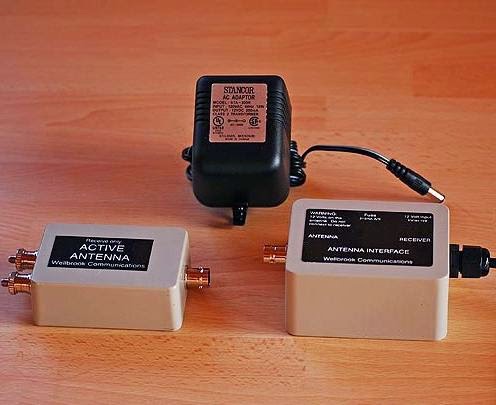 I've had the Wellbrook loop preamp here for a few months, so it was now or never, while the weather was still 'antenna-friendly'. Now I do understand that this goes against one of ham radio's long-standing traditions that dictates all antenna work must wait until the weather can't get any worse. Antennas built in the winter rain always work much better than ones put up in the summer. Hopefully it's not Wouff-Hong or Rettysnitch punishable but the fall DX season is almost upon us and I'm not waiting for the rain!
I've had the Wellbrook loop preamp here for a few months, so it was now or never, while the weather was still 'antenna-friendly'. Now I do understand that this goes against one of ham radio's long-standing traditions that dictates all antenna work must wait until the weather can't get any worse. Antennas built in the winter rain always work much better than ones put up in the summer. Hopefully it's not Wouff-Hong or Rettysnitch punishable but the fall DX season is almost upon us and I'm not waiting for the rain!The new 'loop' is not really loop-shaped but is rectangular (10' x 20') and more like a Flag antenna shape. I considered a Flag but really don't need any back-end nulling capability since I'm mainly interested in listening to the east and to the north.
The main boom section is composed of two sections of 1" PVC thick-wall (Schedule 40) pipe joined at the center and reinforced with a 10' section of 2" x 2" Douglas Fir. In addition, the boom has a truss of 1/4" Dacron to take out any end-loading sag. The vertical end sections are 3/4" Schedule 40 PVC pipe, fastened with a T at the boom end. The center mast is made of 2" Schedule 40 ABS pipe with a long section of 1 1/2" ABS nested inside that telescopes upward to anchor the truss ropes and give some additional rigidity to the mast.
 |
| Main boom and mast construction |
 |
| Looping E/W |
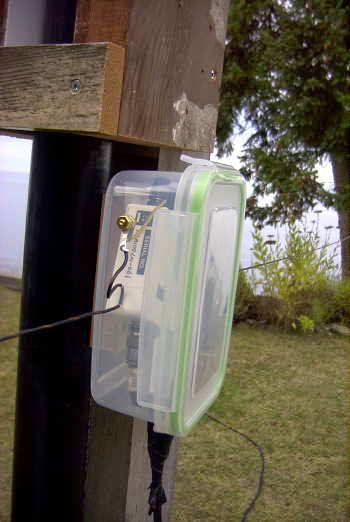
Although the preamp is completely sealed and weatherproofed, I still decided to mount it inside a container. The container also provided a convenient anchor to terminate the loop end wires (PVC-coated #18 stranded) without putting any tension on the soldered terminals.
Although I have not had much time to listen, and conditions are still in 'recovery' mode from earlier disturbances, initial indications are that everything is performing as well, if not better, than expected. It certainly outperforms my 10' active shielded loop by a large margin. I have yet to do any serious S/N comparisons between it and my primary LF receive antenna, a large inverted L, which must be tuned to resonance for the desired listening range. I believe that the very quiet loop / Wellbrook combination will provide an overall S/N improvement.
I have always believed that smaller loops provide deeper and sharper front-to-side nulls so I was pleasantly surprised to measure (using Perseus) null depths from 25-30db, on various groundwave signals ... more than expected. Skywave signals also deliver sharp deep nulls in the order of 22 - 25db ... again surprising, but I'll take them!
A brief listen while pointing S-E last evening turned up good signals from 1 kW'ers KYHN (1650kHz) in Fort Smith, Arkansas and KKGM (1630kHz) in Fort Worth, Texas. An early morning listen revealed good audio from JOIK (567kHz) Sapporo, Japan and JOAK (595kHz) in Shobu. Down in the ndb band, little 25-watter 'IP' on 210kHz was an all-time new catch from Mobile, Arizona.
There is still much to learn from this new antenna system but the biggest challenge will be keeping it up all winter. I did lose one of my 10' loops after several years, due to wind, when the main (un-reinforced) PVC mast eventually failed from flexing fatigue. I will tie the ends of the new antenna down when the winds get strong to reduce as much mast flexing as possible. I could however, run the risk of violating another long-standing radio adage ..."if your antenna stays up all winter, it's not big enough". I just can't win.
Part 3 - Loop Listen
As Murphy would have it, and in spite of the low amount of solar activity, LF/MF propagation has been very poor since getting my new 10' x 20' loop in place. The few front-to-side nulling checks that I have done, have produced results varying from around 20db to 30db, depending upon the signal. I suspect the depth of null is also affected by the signal's arrival angle but there is still more to learn. The pattern seems to be very close to that of a typical circular loop...the classic figure-8 pattern illustrated below as shown on the Wellbrook data that came with my ALA100LN preamp.
 |
| Courtesy: http://www.wellbrook.uk.com |
More typically, the null is around 21-22 db as shown on this test while listening to the ground wave carrier of the 'YZA' NDB (236kHz) located in Ashcroft, B.C., about 150 miles to the NE. As expected, the null is fairly sharp and the front / rear lobe, fairly broad.
One short check at dusk produced nice signals from CJBC, the French-language station in Toronto. The past few nights it has been very strong but with a strong echo effect. I wonder if there is more than one CBC outlet here (860kHz), such as a low-power repeater, causing the echo.
At the same time, while still fairly light outside, WCCO in Minneapolis had a nice signal just before sunset.
No matter how poor conditions become, it seems that the Hinchinbrook (Alaska) NDB, 'ALJ' (233kHz), is always strong ... looping north.
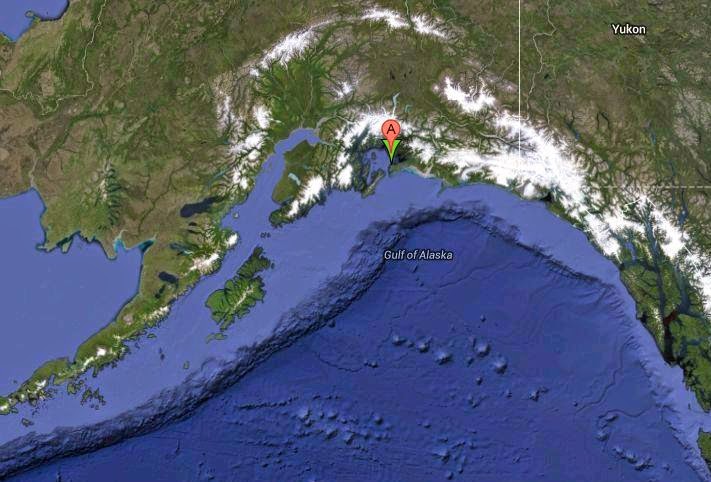 |
| Courtesy: https://www.google.ca/maps |
(Since originally posting the above, I have been using the Tiny Take free screen capturing software, to produce better quality catures of my Perseus recordings. It's also probable that my new iPhone would produce a high quality video of my computer screen compared to the older iPad used for these ones, but it's something yet to be tried.)
Hopefully conditions will only get better as the season progresses and I am able to give the loop a good workout ... before it gets too windy!
 A Long Listen On 1240 KHz
A Long Listen On 1240 KHz
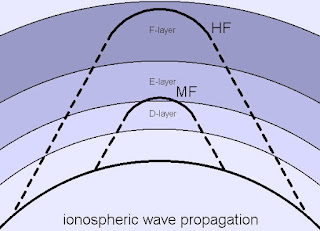 |
| Ionosphere: source |
One of the Broadcast Band’s (BCB) six ‘graveyard’ frequencies is 1240 KHz.
These frequencies (1230, 1240, 1340, 1400, 1450 and 1490 KHz) are assigned to smaller stations running non-directional antennas and up to 1000 watts of power. In North America, there are typically about 150 stations assigned to each frequency.
The origin of this spooky name is often a source of debate. Some suggest that it comes from the cacophony of strange howls and sounds that can be heard on these frequencies at night, as multiple fading signals fight it out to be heard, while others relate it to the similarity of the jam-packed headstones in a typical graveyard. Whatever the true reason, it's a fascinating part of the BCB to explore.
Most BCB DXers enjoy the challenge of tackling the graveyard frequencies as they're often so busy. New stations will fade in for a brief period only to be replaced by a totally different one a few moments later ... and then a different one soon after. It gets even better if the fade-ups coincide with a local ad or a ‘top-of-hour’ ID, putting a new catch in the log!
Several days ago I reactivated my 10’ x 20’ loop and Wellbrook ALA100N preamp, that I use for NDB and BCB DXing, by adding a new buried coax line from the shack.
I had previously re-appropriated the loop’s coax for a nearby HF wire antenna and had been without the loop all winter.
After BCB DXer Mike Cherry (VE7SKA) on Salt Spring Island, the next island to the west of me, described some of the European action that he had experienced last winter, I am determined to not miss out during the next winter's BCB DX season!
 |
| 10' x 20' Loop & Wellbrook ALA100N Preamp |
Once getting the loop powered-up in mid-afternoon, I decided to give it a test by making a ‘deep-search’ on 1240 KHz.
At 1500 hours local time, I wasn’t hearing any audio on 1240 but a weak carrier could be detected audibly. Using my Perseus SDR’s waterfall in its narrowest possible window, produces an extremely narrow passband, effectively increasing the sensitivity by a huge factor. This allows the waterfall to display weak signals that are presently being propagated to my location but far too weak to be heard by ear. I’m estimating that in this narrow bandwidth, it can dig about 30 dB or more into the noise, but there is a price to be paid for this extra gain .... time!
If you're used to watching your receiver’s waterfall scroll along quickly, this mode is just the opposite. It moves in very slow increments, allowing the weaker signals to build up enough to be visible before taking the next deep look. The screen capture shown below is a result of a three-hour listening period, from 1500-1800 hours local time. The entire waterfall is 25 Hz wide, with each tick representing 1Hz.
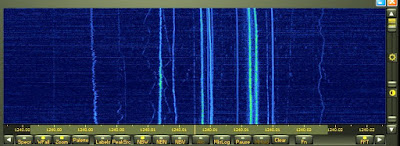 |
| 3-Hour Daylight Deep Search |
Although no signals were clearly audible during this period, my deep-search revealed the carriers of ~28 different stations being received here in south-west British Columbia ... in the middle of a summer afternoon! It’s interesting to note that few of these signals are 100% stable and several can be seen really struggling to maintain their exact assigned frequency. In this highly narrow bandwidth view, even the worst drift amounts to no more than a Hertz, well within the required tolerance of +/- 20Hz.
Using the always-reliable MWLIST, the locations of the most likely candidates for these 28 signals are plotted below. These are the 28 nearest stations and with my loop pointing east, a definite east / south-east flavour is evident.
At mid afternoon, one might expect to see only groundwave-propagated signals on the broadcast band. Midday groundwave on the broadcast band can easily travel a few hundred kilometers, gradually growing weaker over the longer paths. Perhaps all of these signals are arriving via this mode as they are at least 20-30dB into the noise. I initially thought that some of the further-out signals were being reflected from a strong daytime D-layer, although most of the energy would be absorbed. Further reading shows detectable groundwave up to 1200km is possible which coincides nicely with the distances observed. Most likely what I'm seeing is a combination of extended groundwave and D-layer refraction on the furthest signals.
The second screen capture shows the same frequency for another three hours, starting about an hour before local sunset. Some of the weaker signals seen earlier now begin to grow in strength as the D-later absorption starts to decay and reveal the higher E-layer. By the end of the third hour, an additional 41 stations have appeared for a total of 69 carriers cantered on 1240 KHz. (note that my Perseus calibration is off by a few Hz)
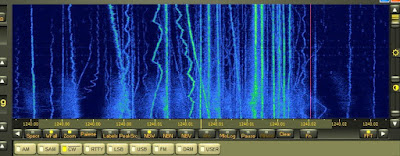 |
| 3-Hour Sunset Deep Search |
The next 41 closest stations are now plotted below in yellow, showing the most likely source of these signals. The distances illustrated are in-line with single and double-hop E-layer or possibly lower F-layer refraction.
This view shows the directional pattern of the front of the loop while pointing east, with its very broad circular lobe. In this direction, the narrow null is only seen along the coast.
It will be interesting to do a mid-winter follow-up on 1240 and compare the present summer propagation to the much better winter conditions. I expect that a some point, propagation via the higher F-layer will be present and extend skip distances out to the east coast or to South America.
In the meantime, things are almost ready for some pre-sunrise looks to the west and some overnight top-of-hour recordings ... as soon as I re-calibrate Perseus!
 CLE240 Results
CLE240 Results
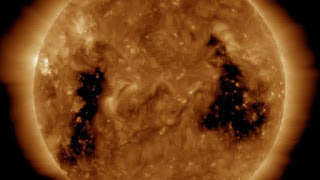 |
| courtesy: NOAA |
Last weekend’s CLE240 saw mediocre propagation for North America and European listeners alike.
It seems that our monthly CLE schedule continues to be synced with the Sun’s monthly rotational period that has been regularly lining us up with the same massive coronal hole, elevating earth-directed solar wind speeds now for several months.
Several CLE participants in the USA commented on the lack of any propagation into BC, further fueling my long-held belief that BC seems particularly sensitive to any geomagnetic activity in the auroral zone to our north. The auroral activity always seems to dip further to the south here for some anomalous reason, as listeners just a few hundred miles to the south or southeast see far less absorption than is observed here.
With a few exceptions, the main effect of these conditions is to largely kill the normal east-west propagation path and just allow single-hop signals from the south or the SE/NW to dominate. Typically, the path to the Pacific is not affected and can often be enhanced.
As a side observation, this past weekend was also the CQWW 160m DX contest and, as one left-coaster commented, conditions were the “worst seen in 10 years”. One would expect to see much better conditions and a much quieter Sun at this point in the solar cycle!
With fingers crossed for better propagation during the next CLE, here is what was logged over the three-night listening event from my location here in BC’s Southern Gulf Islands using a Perseus SDR and an Inverted-L antenna resonated to 400 kHz:
26 05:00 385 QV Yorkton, SK, CAN
26 07:00 385 OCC Yakutat, ALS
26 09:00 385 MR Pacific Grove, CA, USA
26 09:00 385 EHM Cape Newenham, ALS
27 07:00 385 CPZ Chaparrosa Ranch, TX, USA
26 07:00 386 SYF St. Francis, KS, USA
26 09:00 386 HAU Helena, MT, USA
26 06:00 388 OK Preston, OK, USA
26 07:00 388 MM Fort Mc Murray, AB, CAN
26 07:00 388 JW Pigeon, AB, CAN
26 06:00 388 CDX Somerset, KY, USA
26 06:00 389 YWB Kelowna, BC, CAN
26 04:00 389 TW Twin Falls, ID, USA
26 07:00 389 CSB Cambridge, NE, USA
26 07:00 390 HBT Sand Point, ALS
26 11:00 390 AES Northway, ALS
26 04:00 391 TK Telkwa, BC, CAN
26 11:00 391 GXD Nacogdoches, TX, USA
26 07:00 391 EEF Sisters Island, ALS
26 06:00 391 DDP Dorado, PTR
26 09:00 392 ZFN Tulita, NT, CAN
26 05:00 392 PNA Wenz, WY, USA
26 05:00 392 ML Charlevoix, QC, CAN
26 08:00 392 FMZ Fairmont, NE, USA
26 10:00 393 UKS Kosrae, FSM
26 04:00 394 RWO Kodiak, ALS
26 07:00 394 DQ Dawson Creek, BC, CAN
26 07:00 395 YL Lynn Lake, MB, CAN
26 04:00 395 ULS Ulysses, KS, USA
26 07:00 395 5V Drumheller, AB, CAN
26 07:00 396 YPH Inukjuak, QC, CAN
26 05:00 396 CRS Corsicana, TX, USA
26 05:00 396 CMJ Ketchikan, ALS
26 07:00 397 ZSS Saskatoon, SK, CAN
27 12:00 397 SB San Bernardino, CA, USA
26 10:00 398 YOD Cold Lake, AB, CAN
26 06:00 398 3D Cumberland House, SK, CAN
26 11:00 399 ZHD Dryden, ON, CAN
26 11:00 399 SRI Pribilof, ALS
A summary of results for all participants can be found here, at the ndblist info site.
 CLE237 Results
CLE237 Results
 Last weekend's CLE237 was truly a workout. Not only was the format challenging, hunting for different grid square fields, but propagation was superb ... a vast departure from the normal CLE propagation-curse!
Last weekend's CLE237 was truly a workout. Not only was the format challenging, hunting for different grid square fields, but propagation was superb ... a vast departure from the normal CLE propagation-curse!This combination resulted in many daytime hours spent reviewing three nights of Perseus recordings, the downside of being able to sleep all night rather than staying up until 0300 while listening live!
All told, 118 NDBs in 41 different grid fields were logged. Of these 118 stations, 12 were 'new catches'. After DXing NDBs since 1985, new catches are getting harder and harder to find but last week's great conditions were the best heard here in several years.
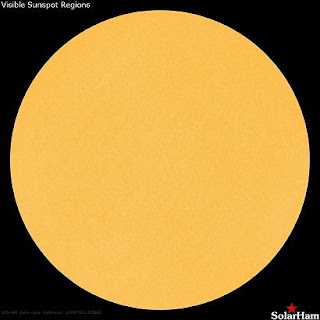 |
| Today's quiet Sun! |
With a very quiet Sun for a couple of weeks now, these great MF conditions are what many have been waiting for since the last solar low many years ago ... propagation below the broadcast band can be truly remarkable when these quiet conditions continue for many weeks at a time.
Here are a few interesting CLE catches as recorded on the Perseus SDR.
NDBs QY (Sydney, Nova Scotia), YBB (Pelly Bay, Nunavut)and 3Z (Russell, Manitoba) all sharing 263kHz within a few Hz of each other.
My full CLE237 log is shown below. As usual, a Perseus SDR and an 'inverted-L' (resonated to 300kHz) was used for the activity.
AH
28 13:30 403 TUT Pago Pago, SMA
AL
28 13:30 400 MDY Midway, MDW
AO
27 12:30 283 DUT Dutch Harbor, ALS
27 12:30 341 ELF Cold Bay, ALS
27 12:30 385 EHM Cape Newenham, ALS
27 12:30 390 HBT Borland, ALS
AP
27 06:00 263 OAY Norton Bay, ALS
27 13:30 275 CZF Cape Romanzof, ALS
27 13:00 325 BVK Buckland, ALS
27 13:30 347 TNC Tin City, ALS
27 13:00 356 HHM Kotzebue, ALS
BG
27 13:30 352 RG Rarotonga, CKS
BK
27 13:30 332 POA Pahoa, HWA
BL
27 14:00 353 LLD Lanai, HWA
BO
27 12:00 277 ACE Kachemak, ALS
27 12:00 355 AUB King Salmon, ALS
27 12:00 394 RWO Kodiak, ALS
27 12:00 411 ILI Iliamna, ALS
27 12:00 429 BTS Dillingham, ALS
BP
27 12:00 212 CGL Juneau, ALS
27 13:00 257 CUN Fairbanks, ALS
27 12:00 346 OLT Soldotna, ALS
27 12:30 347 DJN Delta Junction, ALS
27 12:00 350 VTR McGrath, ALS
BQ
27 13:00 376 PVQ Deadhorse, ALS
CN
27 06:00 378 AP Mayne Island, BC, CAN (MY NEAREST)
27 12:00 266 SLE Salem, OR, USA
27 07:00 356 PND Portland, OR, USA
27 06:00 356 MEF Medford, OR, USA
27 06:00 404 MOG Montegue, CA, USA
CM
27 07:00 203 TCY Tracy, CA, USA
29 04:00 385 MR Pacific Grove, CA, USA
CO
27 12:00 266 ICK Annette Island, ALS
27 12:00 358 SIT Sitka, ALS
27 12:00 396 CMJ Ketchikan, ALS27 12:00 414 IME Sitka, ALS
27 12:00 529 SQM Sumner Strait, ALS
CP
27 13:30 222 WY Wrigley, NT, CAN
27 11:30 254 EV Inuvik, NT, CAN
27 14:00 284 YOC Old Crow, YT, CAN27 08:00 380 YUB Tuktoyaktuk, NT, CAN
27 12:00 392 ZFN Tulita, NT, CAN
CQ
29 06:00 321 YSY Sachs Harbour, NT, CAN
DM
27 08:30 242 EL El Paso, TX, USA
27 10:00 278 CEP Ruidoso, NM, USA
27 06:00 326 MA Midland, TX, USA
27 12:00 338 RYN Tucson, AZ, USA27 13:00 341 OIN Oberlin, KS, USA
DN
27 09:00 233 BR Brandon, MB, CAN
27 09:00 275 HIN Chadron, NE, USA
27 09:00 383 CNP Chappell, NE, USA
27 09:00 400 FN Fort Collins, CO, USA
27 09:00 414 GRN Gordon, NE, USA
DP
27 08:00 207 PY Fort Chipewyan, AB, CAN
27 08:00 212 BY Beechy, SK, CAN
27 08:00 219 ZRS Regina, SK, CAN
27 08:00 221 QU Grande Prairie, AB, CAN
27 08:00 230 VG Vermilion, AB, CAN
DQ
27 08:30 361 HI Holman, NT, CAN
EL
27 06:00 260 MTH Marathon, FL, USA
27 10:00 269 AR New Iberia, LA, USA
27 10:00 329 HMA Hondo, TX, USA
27 06:00 332 FIS Key West, FL, USA
EM
27 07:00 263 CVM Alton, IL, USA27 07:00 332 IC Wichita, KS, USA
27 07:00 335 BV Batesville, AR, USA
27 07:00 338 UMP Indianapolis, IN, USA
27 07:00 349 GW Greenwood, MS, USA
EN
27 12:00 257 JYR York, NE, USA
27 06:00 329 PMV Plattsmouth, NE, USA
27 06:00 360 SW Warroad, MN, USA
27 08:00 368 VIQ Neillsville, WI, USA
27 09:00 368 PNM Princeton, MN, USA
EO
27 07:00 212 YGX Gillam, MB, CAN
27 08:00 216 YFA Fort Albany, ON, CAN
27 08:00 218 RL Red Lake, ON, CAN
27 08:00 224 MO Moosonee, ON, CAN
27 08:00 258 ZSJ Sandy Lake, ON, CAN
EP
27 06:00 224 BK Baker Lake, NU, CAN
27 09:00 241 YGT Igloolik, NU, CAN
27 08:00 263 YBB Kugaaruk, NU, CAN
27 10:00 329 YEK Arviat, NU, CAN
27 10:00 335 YUT Repulse Bay, NU, CAN
EQ
27 04:00 365 YGZ Grise Fiord, NU, CAN
FI
27 05:00 365 PAL Palma, EQA
FK
28 05:00 369 ZDX Saint Johns, ATG
27 06:00 391 DDP Vega Baja, PTR
27 05:00 415 CBC Cayman Brac, CYM
FL
27 09:00 376 ZIN Matthew Town, BAHFM
29 05:00 198 DIW Dixon, NC, USA
FN
27 08:00 289 YLQ La Tuque, QC, CAN
27 08:00 373 YXK Rimouski, QC, CAN
27 05:00 392 ML Charlevoix, QC, CAN27 05:00 407 ZHU Montreal, QC, CAN
27 07:00 516 YWA Petawawa, ON, CAN
FO
27 10:00 208 YSK Sanikiluaq, NU, CAN
27 18:37 323 KR Schefferville, QC, CAN
27 10:00 351 YKQ Waskaganish, QC, CAN
27 10:00 390 VP Kuujjuaq, QC, CAN
27 08:00 396 YPH Inukjuak, QC, CAN
FP
27 09:00 277 YLC Kimmirut, NU, CAN
27 10:00 338 YPX Puvirnituq, QC, CAN
28 10:00 358 YKG Kangiqsujuaq, QC, CAN
FQ
29 07:00 256 YCY Clyde River, NU, CAN
GN
27 10:00 263 QY Sydney, NS, CAN
27 08:00 280 QX Gander, NL, CAN
27 08:00 350 DF Deer Lake, NL, CAN
GO
28 08:00 220 BX Lourdes de Blanc, QC, CAN
28 08:30 281 CA Cartwright, NL, CAN
28 10:00 396 JC Rigolet, NL, CAN
GQ
28 06:00 399 UP Upernavik, GRL
QJ
27 12:00 366 PNI Pohnpei Island, FSM
QL
27 13:00 343 ML Minami Tori Shima, MTS
27 12:00 360 OX Iwo Jima, VOI
QO
28 13:30 437 OG Okha, RSE
RG
27 12:30 260 NF Norfolk Island, NFK
RJ
27 12:00 316 MAJ Majuro Atoll, MHL
27 12:00 393 UKS Kosrae, FSM
As always, complete CLE results (worldwide) can be viewed in detail here.
All-in-all, an exhausting but delightful weekend of listening and great propagation ... so many signals to hear ... welcome to solar-low!
 CLE 235 Results
CLE 235 Results
 |
| BF-362 Seattle |
As it turned out, summer lightning noise was the least of CLE 235's problems!
The weekend event saw its all too often 'solar hit' shortly after the start of the event, with Friday evening being the only night (in North America anyway) that had propagation. Saturday and Sunday nights were almost complete blackouts, with just one catch recorded on each night.
With the K-index soring to at least 7, there was really not much to be heard after Friday night save for a very robust appearance from RG-352 at the Rarotonga International Airport, just before dawn on Sunday morning. Thanks to Dan, VE7DES, listening from the club station at UBC, for the tip!Disturbed conditions often seem to enhance the Pacific path but other than Hawaii, this was the only other signal heard from the west. Sunday morning found DPY-365 in Washington state. Up until that time, its signal had been completely missing-in-action ... but it was loud at 0100 local. Perhaps it had been down for maintenance and not on the air until Sunday.
 |
| courtesy: NOAA |
My log consisted of 30 stations, with all but two from Friday night before the storm. As usual, the receiver was a Perseus SDR and an 'Inverted-L', resonated at 300 kHz.
25 07:00 350 VTR McGrath, ALS
25 12:00 350 SWU Idaho Falls, ID, USA25 08:00 350 RG Oklahoma City, OK, USA
25 07:00 350 NY Enderby, BC, CAN
25 07:00 351 YKQ Waskaganish, QC, CAN
26 12:00 352 RG Rarotonga IAP, CKS
25 07:00 353 ZXY Whitehorse, YT, CAN
25 08:00 353 PG Portage La Prairie, MB, CAN
25 13:00 353 LLD Lanai Island, HWA
25 07:00 353 AL Dixie, WA, USA
25 12:00 355 AUB King Salmon, ALS
25 12:00 356 ZXE Saskatoon, SK, CAN
25 08:00 356 ZF Yellowknife, NT, CAN
25 08:00 356 PND Portland, OR, USA
25 08:00 356 ON Penticton, BC, CAN
25 12:00 356 MEF Medford, OR, USA
25 09:00 358 SIT Sitka, ALS
25 09:00 359 YQZ Quesnel, BC, CAN
25 09:00 359 YAZ Tofino, BC, CAN
25 07:00 361 HI Holman, NT, CAN
25 07:00 361 E3 Wabasca, AB, CAN
25 07:00 362 YZS Coral Harbour, NU, CAN
25 07:00 362 RPX Roundup, MT, USA
25 07:00 362 BF Seattle, WA, USA
25 08:00 362 6T Foremost, AB, CAN
25 07:00 365 YGZ Grise Fiord, NU, CAN
25 12:00 365 MA Mayo, YT, CAN
27 08:00 365 DPY Deer Park, WA, USA
25 07:00 365 AA Harwood, MN, USA
25 12:00 368 ZP Sandspit, BC, CAN
25 12:00 368 VX Dafoe, SK, CAN
The results from ALL participants may be viewed here.
 Recent Noise Mystery Solved
Recent Noise Mystery Solved
You may recall a recent blog regarding my installation of a new pair of inverted-V dipoles, fed from a common coaxial feedline at around 85'. Both antennas 'hear' very well and everything was peachy until I recently put the inverted-V's on my Perseus SDR.
I had been particularly interested in using the new high antennas for my general shortwave listening on 40m and below but what I observed was immediately troubling when listening on the 5 - 6MHz, 49m band. After much head-scratching about what I had noticed, I posted the following 'help' message to the Perseus reflector as well as to the Perseus SDR Facebook site:
Perhaps others can help explain something odd that I have just noticed with my Perseus while comparing antennas.
I was comparing signal levels and noise between a 40m half sloper and a very high dual 40/80m pair of inverted-V dipoles fed from a common feedline. Both the sloper and the dipoles are fed with 50 ohm cable and all three antennas are well matched at the low end of the band(s).
Listening to a 6 MHz signal from China National Radio around 10 am today, the signal was around S7-8 on the Perseus, using the 40m sloper. Listening to the same signal, at the same time, on the Yaesu FT-1000mp, with the high inverted-V, it was slightly better, maybe by 5-6 db and overall lower noise. I then put the inverted-V onto the Perseus and there was not even a trace of the signal! I made this check with several signals and always with the same result.
Now I suspect that the SWR of the 7MHz inverted-V when used at 6MHz, is very high and the load presented to the Perseus antenna input is likely highly reactive and far from 50 ohms but that doesn't seem to bother the FT-1000.
I then ran the inverted-V through my antenna tuner so that it effectively produced a 50 ohm non-reactive input load for the Perseus and did the tests again...with the same results. Swapping antennas for the 40m sloper once again produced the same signal levels in both the Perseus and the FT-1000.
So what is going on here and why does the Perseus balk at the 7 MHz inverted-V while listening on 6 MHz? Is there something in the Perseus front-end analog filtering system that is overly sensitive even though the reactance was tuned out via the tuner? Is it the 80m V on the same feedline as the 40m V that is causing some still unwanted reactance that is not tuned out with the tuner?
Any ideas what is happening here as it looks like I will not be able to use the inverted-V antennas on the Perseus for general SWL out-of-band listening for some, as yet unknown, reason.
As you can see, I was completely mystified by what I was hearing, or rather not hearing, and as it turned out, completely off the mark.
I received a few replies offering some possible reasons for what I was seeing but none of them proved helpful in solving my dilemma ... until Roelof Bakker (PAØRDT) weighed-in! Roelof suggested that I look at the antenna's performance while running Perseus's built-in 'HFSpan' function.
HFSpan is a stand-alone 0-40MHz spectrum analyzer, that comes with the Perseus software. Although I was aware of it, I have only used it sparingly. I next did some screen captures with all three antennas, one at a time, and sent them to Roelof.
His analysis did not take long as he immediately identified my problem ... a very high noise floor when using the mysteriously-performing inverted-V. Roelof suggested some common mode choking to eliminate the problem.
Already having an isolating transformer in hand from a previous experiment, I inserted it directly at the Perseus antenna input and looked at the noise floor again, around 40m. The transformer was wound on a small FT87-J core with a 3 turn primary directly opposite a 3 turn secondary. I was astounded to see the background noise floor drop from -85dbm to a very quiet -110dbm!
Evidently there was a lot of noise being picked-up on the inverted-V's feedline shield. Not hearing any of this noise on the FT-1000 indicated that the noise was probably associated with the Perseus power supply, the laptop or the laptop's power supply. This immediately explained why I wasn't hearing anything with this antenna when used with the Perseus.
Roelof then suggested that a 2 turn / 2 turn transformer, offering less inter-winding capacitive coupling, might provide even more isolation ... and he was right again. A further ~4dbm lowering of the ambient noise was measured.
| It may not be pretty but it produced an astounding improvement! |
Further comparisons between the FT-1000 and the Perseus revealed that the FT-1000 was still producing a slightly better SNR than the Perseus, when using the inverted-V so evidently there was still some noise affecting the signal. I had a few very large #43 ferrite toroids and decided to wrap a few turns (5) of the RG8-X feedline around the toroid to see if there would be any improvement.
Once again, using HFSpan, I compared the noise floor both with and without the #43 choke and saw a further 6-7 dbm improvement! Going back to comparing SNRs between the FT-1000 and the Perseus, I now saw no difference between how I was hearing on both receivers, when using the troublesome inverted-V ... eureka!
Here are the 'before' and 'after' screen shots using HFSpan, the Perseus built-in spectrum analyzer. Both screen shots were taken at the same time (mid-afternoon) and show the results of the noise mitigation work.
 |
| Same sweep, noise eliminated, signals now unmasked |
As of yet, I have not determined the actual noise source. I suspected it may have been coming from the Perseus power supply or from the laptop supply but that was not the case. Perhaps it is coming from the laptop's processor via the USB cable which I will also choke and see if HFSpan reveals anything further
This problem was a great learning experience for me, in more ways than one and I am most grateful to Roelof for his detective work and experience with noise issues and for taking the time to respond to my initial inquiry. Hopefully you may find something here that can help you as well.

